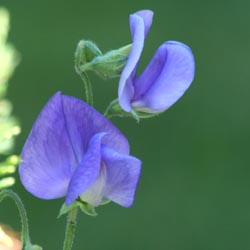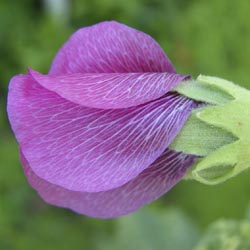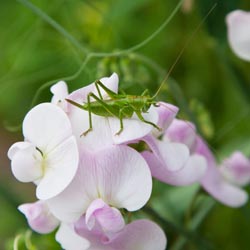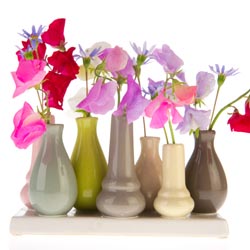For many of us, it’s the sweet pea that declares, “spring is here!” The colors and sweet fragrance announce the coming of warmer days like no other.
The hardest part of growing sweet peas is choosing from the riot of colors. From the palest of pastels to the most vivid of hues (including stripes), reds, pinks, white, blues, purples, yellows…the list seems endless. Many gardeners buy mixed packages of seeds to avoid the decision.
Look at your choices. Do some of the packets confuse you? Wondering about the difference between “tendril” and “non-tendril?” If the seed package says “tendril” this means the plants have small green growths to attach to a surface or netting to help the vine grow upright. This is how the taller sweet pea vines support themselves as they grow to 6′ (or more!). The varieties with no tendrils remain more compact, making them great in containers. Some of these will trail downward. Other dwarf non-vining varieties act as annual fillers in the mixed garden bed or as borders. What fun!
They’re super easy to grow…just sow the seeds 2″ deep in rich well-draining soil in a full to partial sun location. If the soil is heavy, add compost to improve the texture. Keep the soil moist. Germination should occur within 10-28 days. Continue even and consistent watering. When seedlings are 4-5″ tall, thin to create 5-6″ spacing between plants. To encourage bushy and compact plants, pinch the tips when three sets of leaves form. Generally, do not provide additional fertilizer, otherwise the plants may be lush but the flowers will be sparse.
Sweet Pea Secret! Improve the germination rate, especially of the darker colors, by using nail clippers to nick the seed coat and soak overnight before planting.
If you’re impatient, consider buying seedlings from your garden center. This way you’ll have fragrant sweet pea bouquets a month earlier. Here’s another secret, remove any flowers when transplanting. Yes, this is difficult, but it encourages stronger root growth to produce larger flowers later. You’ll be glad you did it.
Those long-lasting, colorful and fragrant flowers are so sweet in large loose arrangements. They’ll easily last a week if you change the water daily and snip off a bit of the stem. Remember, the best way to extend the sweet pea blooming season is by daily picking early in the day. Definitely, not too difficult.
Seeds for perennial sweet peas are also available. Unlike annual sweet peas, the perennial plant will continue to bloom throughout our warm, humid summers. Annual sweet peas tend to have a gloriously heady scent. This is a feature sorely lacking in the perennial form.
By the way…if you just can’t get enough of your annual sweet peas, grow them again in the autumn. Yes, you can! Why do most of us only grow sweet peas in the spring? Probably because we just don’t think about them in the fall. However, they grow just as well in the cool autumn as the spring. Just remember to provide enough time for flowering before the first frost hits.










